When I left you last week, I had so much more to share about the vineyards and wineries we visited on our trip to Napa Valley. I told you about Opus One, where they only make one wine per year and about all the yummy food we ate. Now more on on the wines and wineries:
On our first day, before we even got to Chateau de Vie, we drove over the Golden Gate Bridge from San Fran. We left early early Monday morning, and there was so much fog, we couldn’t even see the bridge WHILE we were driving over it. Oh well.
We veered off to Sausalito which was still quite quiet and stopped for a croissant and a coffee at a local bakery “overlooking” the bridge, which was still shrouded in fog, so no go on that photo op. However, I actually much prefer this foggy, grey, dramatic sky, which I think is more interesting and evocative than a bright sunny day anyway:
We arrived in Napa way too early for our 11am tour at Domaine Carneros (sparkling wine made in a traditional French fashion: “methode champenoise”), so we went to Oxbow Market in Napa to wander around and find a snack. It’s like an upscale version of Cross Street Market in Baltimore. Instead of dirty floor water, there were wine and cheese bars, a spice counter, an oyster bar (okay that might be in Cross Street Market also), and this ginormous pumpkin that must have won some sort of award:
 I like the small pumpkin next to it for scale 🙂
I like the small pumpkin next to it for scale 🙂
Then off we went to Domaine Carneros, where the tour gave a very detailed overview of the champagne-making process. There was great information for those of us taking notes (okay, that was just me). After initial fermentation in huge vats/barrels/drums (whatever you want to call them), yeast is added and the sparkling wine is bottled for secondary fermentation (what gives the CO2 bubbles). In the old days (and at some places, still) they would keep the bottles neck down in a wooden plank (“riddling rack”) and the “riddlers” would have to come by every day to turn each bottle ever so slightly to loosen any yeast that was stuck to the sides of the bottle. The dead yeast cells would fall into the neck of the bottle and collect there. At this point in the process, there is a beer-bottle type cap on the bottles, not a cork, because it can best hold in the pressure accumulating from the CO2 produced from the fermentation.
 This “riddling” system was invented by Veuve Clicquot (of French Champagne fame), whom I hadn’t realized was an actual person – and a woman at that – woo woo! At Domaine Carneros, they now have huge machines that do the riddling:
This “riddling” system was invented by Veuve Clicquot (of French Champagne fame), whom I hadn’t realized was an actual person – and a woman at that – woo woo! At Domaine Carneros, they now have huge machines that do the riddling:
 (At Schramsberg, another sparkling winery we went to, they still have people doing the riddling by hand…our tour guide there, Martha, said a single riddler could turn 50,000 bottles a day!!)
(At Schramsberg, another sparkling winery we went to, they still have people doing the riddling by hand…our tour guide there, Martha, said a single riddler could turn 50,000 bottles a day!!)
After a period of time when all the lees (dead yeast cells…they die when there isn’t any sugar left in the wine for them to consume) fall into the neck of the bottle, the neck is flash-frozen with glycol and the frozen yeast plug is extracted. Some sugar is added back into the sparkling wine at that point or else it would taste disgusting (process called “dosage”) and then the real cork is inserted into the bottle. I understood that a champagne cork doesn’t start off the way it looks when you pull it out of the bottle, but I wasn’t prepared for how fat it was to begin with!! It makes sense, I just never thought about it before. Here is a before and after shot of the cork in sparkling wine:
Look at all that wine they’ve opened!
 They taught us the proper technique (and most safe way) to open a sparkling wine bottle: 1. Keep the bottle very cold so that the CO2 pressure is minimized; 2. After you take off the foil (which is now decorative but was originally used to hide inconsistencies in the level of the wine across different bottles) and unwind the cage, keep the cage on! 3. Always have you hand across the cork, don’t just set it down on the table without the cage because it could pop off! 4. Press into the cork as you twist the bottle 5. Then the cork will come out with a tiny pop of air and won’t hit you in the eye. P.S. Do not eyeball the top of the cork until it is out of the bottle, lest you lose an eye. (I recently tried this technique for the first time…it was sort of difficult and I was so scared….I hate opening champagne anyway….small pop but then the champagne started really flowing out of the bottle into the sink….not sure if that was poor technique or just a bad bottle.)
They taught us the proper technique (and most safe way) to open a sparkling wine bottle: 1. Keep the bottle very cold so that the CO2 pressure is minimized; 2. After you take off the foil (which is now decorative but was originally used to hide inconsistencies in the level of the wine across different bottles) and unwind the cage, keep the cage on! 3. Always have you hand across the cork, don’t just set it down on the table without the cage because it could pop off! 4. Press into the cork as you twist the bottle 5. Then the cork will come out with a tiny pop of air and won’t hit you in the eye. P.S. Do not eyeball the top of the cork until it is out of the bottle, lest you lose an eye. (I recently tried this technique for the first time…it was sort of difficult and I was so scared….I hate opening champagne anyway….small pop but then the champagne started really flowing out of the bottle into the sink….not sure if that was poor technique or just a bad bottle.)
Next, we went to Artesa, which is almost across the street from Domaine Carneros. These wineries are in the Carneros Region just south of Napa where the temperatures are slightly cooler given the breezes off the San Pablo Bay to the south. These cooler climates (and really every hillside and valley and shady patch under a tree is its own microclimate…the owner of Storybook Mountain winery told us that within 40 acres of planted grapes – so not a lot by Napa standards – they’ve divided 105 subplots, each with its own weather conditions that may change the kind of grape planted there, how much they water, etc.) are better for growing pinot noir grapes and chardonnay grapes used for sparkling wines. So for instance, Domaine Carneros also produces a pinot noir in addition to their sparkling wines (some of which are a mix of chardonnay and pinot noir grapes).
Artesa is owned by a Spanish family who also has wineries in Spain and Argentina. We tasted a sparkling Spanish cava which was delicious!! Not as tart as the American brut sparkling wines I’m used to, but not totally syrupy sweet either…somewhere in between…that you could actually perhaps drink with food. From their American winery, we tasted a chardonnay and two different delish pinot noirs (one that we ended up purchasing). It was an interesting comparison tasting because one was an estate pinot noir (meaning all the grapes going into that came from the surrounding Artesa-owned vineyards) and one was not estate (grapes from vineyards on site have been mixed with grapes from vineyards offsite, either Artesa-owned or not…or all grapes have come from offsite). The estate wine definitely had a stronger taste and perhaps more tannins (that puckering sensation you get on the side of your tongue from red wine), such that I preferred the mixed pinot better.
At Artesa, our host was Anne, a petit Englishwoman whom I really liked (but maybe that was because she was super friendly, chatty, and seemed to validate my opinions on what we were tasting).

 Our welcome sign above! So cool!! (Our host thought we were married so all our reservations were under Mark and Hannah Lowe 🙂 )
Our welcome sign above! So cool!! (Our host thought we were married so all our reservations were under Mark and Hannah Lowe 🙂 )
We had a private tasting with her and short tour of the winery which was so modern and cool:
 Sculpture leading up to Artesa
Sculpture leading up to Artesa  Amazing water feature
Amazing water feature Entering Dr. Evil’s underground lair it seemed
Entering Dr. Evil’s underground lair it seemed Viewing windows built like black pyramids out of the side of the winery.
Viewing windows built like black pyramids out of the side of the winery.
One feature which I thought was super nifty was that each of this family’s wineries has a replica statue of the Virgin Mary. The very old, original statue was unearthed as they were digging the original vineyard in Spain. What makes this Mary special is that she is depicted with braids – the harvest Mary – which is very rare, as Mary is usually shown with her hair covered completely as a sign of modesty. I thought it was pretty fortuitous that a harvest Mary was unearthed while digging a wine farm essentially! Additionally, at Atesa, she is placed in a pool of water in a courtyard surrounded by thick columns. Due to the architectural design, a hologram of her is projected into the tasting room, when the light is right. It’s not a true reflection because there are columns in her way, and no matter where you move within the courtyard, her hologram stays put inside.
 The light isn’t perfect to view her, but you get the point.
The light isn’t perfect to view her, but you get the point.
Tuesday, we started early with a 9am private tour at Storybook Mountain, known for their Zinfandels. We wandered through some redwoods with our guide – the son-in-law of the owner – who told us the history of the winery.  Mark among the redwoods.
Mark among the redwoods.
It was originally started in the 1880s by Jacob and Adam Grimm of Germany. They were some of the first winemakers in Napa along with the other Jacobs: Jacob Schramsberg and Jacob Beringer. When the vineyard was taken over in the 1970s after years of abandonment after a fire in the 1960s, Jerry, the owner (pictured below, whose daughter is the head winemaker….another UC Davis grad, as all winemakers in Napa seem to be) didn’t want to call it the Grimm winery because that just sounds unpleasant. So they named it Storybook after the Grimm fairy tales. Jerry’s wife, an artist, carved this huge barrel to commemorate the history.
 Jerry tasting wine at 9am – “never too early to taste some wine!”
Jerry tasting wine at 9am – “never too early to taste some wine!”
 Barrel depicting story of the vineyard
Barrel depicting story of the vineyard
 Storybook is in the Northern-most part of Napa with a lovely view of Mt. St. Helena, the largest peak in Mayacamas Mountains.
Storybook is in the Northern-most part of Napa with a lovely view of Mt. St. Helena, the largest peak in Mayacamas Mountains.
Later on Tuesday, we headed to Schramsberg, which also makes sparkling wines. Schramsberg wine became famous when it was served at the “Toast to Peace” State dinner in China between President Nixon and the Chinese president. Barbara Walters picked a bottle from the table and used it in her news piece, which then launched the wine’s popularity. It has been used in many State and White House dinners since.
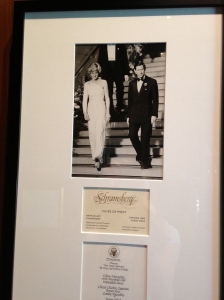 Even Charles and Di drank Schramsberg.
Even Charles and Di drank Schramsberg.
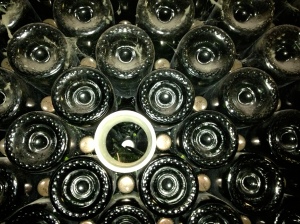 Here’s what they do if a bottle explodes under CO2 pressure while being stored….they just replace it with a piece of PVC tube to hold the structure in place.
Here’s what they do if a bottle explodes under CO2 pressure while being stored….they just replace it with a piece of PVC tube to hold the structure in place.
 Wall of bottles being stored. Schramsberg has 34,000 square feet of underground caves in which to store their wine. Both their caves and those at Storybook were partially dug by Chinese railroad workers who were looking for work after the transcontinental railroad was completed in the late 1800s. (Notice the mold growing on the ceilings…apparently that’s good.)
Wall of bottles being stored. Schramsberg has 34,000 square feet of underground caves in which to store their wine. Both their caves and those at Storybook were partially dug by Chinese railroad workers who were looking for work after the transcontinental railroad was completed in the late 1800s. (Notice the mold growing on the ceilings…apparently that’s good.)
 How they label and track the stored bottles. In this batch, which was put away in 2008, there are over 24,000 bottles!
How they label and track the stored bottles. In this batch, which was put away in 2008, there are over 24,000 bottles!
Tuesday afternoon, we headed to Castello de Amorosa. We didn’t have a tasting our tour scheduled, but we wandered around the outside of this castle that was built after traditional Italian castles, but in the 1990s, just to produce and store wine! After reading this “About” blurb on their webpage, it might be worth the $20 entrance fee next time around to see the dungeons and hidden passageways. There’s also a moat!!
Wednesday we headed over to Sonoma – about a 45 minutes ride from our B&B (actually more since we passed it and got completely lost for a while) to tour Jordan winery, where we had a very friendly guide, Jason, who showed us grapes being brought in from harvest. Jordan also has a fully functioning farm, and their full-time chef, Todd Knoll, came from the Ritz in San Fran. We not only had a cheese-wine pairing here, but we also had smoked salmon crostini with the chardonnay.  Jason pouring our morning Chardonnay.
Jason pouring our morning Chardonnay. Salmon breakfast
Salmon breakfast Overlooking the farm
Overlooking the farm  Grapes coming in from harvest
Grapes coming in from harvest They are letting these barrels air out after being cleaned. I stuck my head in the hole and then a worker yelled at me because apparently there were incredible amounts of sulfur fumes coming out of there and he said I would die. My bad!
They are letting these barrels air out after being cleaned. I stuck my head in the hole and then a worker yelled at me because apparently there were incredible amounts of sulfur fumes coming out of there and he said I would die. My bad!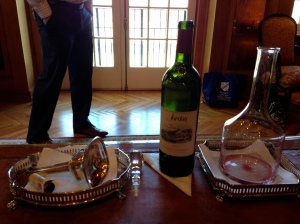 This was some pretty tasty wine we had at Jordan.
This was some pretty tasty wine we had at Jordan. Secret passageways!! Love.
Secret passageways!! Love.  Cheese plate, Jordan olive oil (very peppery) and pickled fig chutney off in the corner there.
Cheese plate, Jordan olive oil (very peppery) and pickled fig chutney off in the corner there. Some really really large bottles of wine.
Some really really large bottles of wine.
We had lunch at Coppola winery in Sonoma, which is like an amusement park/tourist trap, so we had very low expectations. In fact, we really enjoyed the wine we tasted there (and they were super cheap comparatively), and we also had a delicious lunch on their terrace at Rustic, the restaurant onsite. I had a fresh arugula pizza and chocolate pot de creme that was too rich to even eat half of, served in a tiny tea cup. There is a pool at which you can rent a day cabana, and lots of Coppola’s movie memorabilia.
 Throwback-style cabanas
Throwback-style cabanas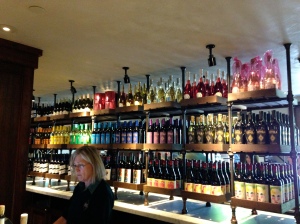 A whole rainbow of wine. This was our taste pourer – I don’t remember her name, but she is from Boston and recently moved to CA to be closer to her grown children.
A whole rainbow of wine. This was our taste pourer – I don’t remember her name, but she is from Boston and recently moved to CA to be closer to her grown children.
Thursday we had two morning tastings back in Napa: at Conn Creek and Chimney Rock, followed by a tour and tasting at Cade, which was on Food&Wine’s list of must-visit Napa wineries. Conn Creek had one really tasty wine, called Anthology, which we hear can be aged for a quite a number of years before it really hits its prime….note to self: put a sticky note on that one making sure not to drink it for a while. The unique thing about Conn Creek, which I definitely want to do next time we are in Napa, is they take 10 people a day, and for $95 each, you can sample pure grape varietals and then blend your own wine to suit your fancy! So cool! I asked if anyone had ever produced anything in this class that the winery then went on to mix, bottle and sell. Apparently not. Oh well.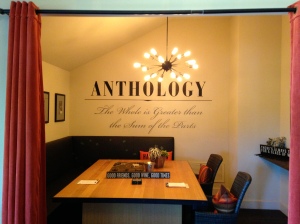
I loved Chimney Rock – I thought their wines were some of the best we had. This is a Terlato vineyard, of which there are a few, and Terlato also imports and distributes lots of other wines. For instance, Santa Margherita Pinot Grigio that I love is imported by Terlato. You may have also heard of Terlato from Top Chef – I think they are always hyping that brand. I bought Anthony Terlato’s book “Taste” for $3.50 on my Kindle and can’t wait to read it – part autobiography, part business book is the sense I get.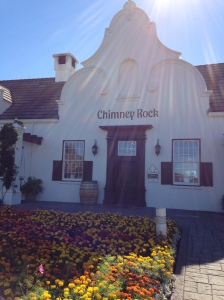
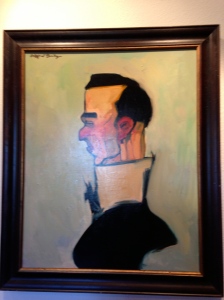

I also loved the local art they had on the walls at Chimney Rock. Our host said that it changes from time to time and this was a new show, so he didn’t know anything about the artist. Too bad they weren’t cheaper or else I would have purchased one!!
Cade was the last winery we visited on Thursday, and while the physical location was stunning, I was less impressed with the wines, although that may have been tainted by our super pretentious guide. He had such a “whatever” attitude (although he may have been a bit toasted, as it was 4pm and he no doubt had many other tours before ours), spoke really fast and didn’t explain anything. He didn’t inspire us to start conversation among the group (something that naturally happened most everywhere else by the end of the tour) and he poo-pooed some of the local restaurants we had been to already and enjoyed (“good isn’t good enough for Napa”). I’m glad we went if only for the beautiful scenery and weather, but needless to say we didn’t buy anything and left with a sour taste from all the eye-rolling.

 Nice outdoor lounge area
Nice outdoor lounge area
 This is the tree on which Cade based their logo’s symbol
This is the tree on which Cade based their logo’s symbol 

 Cade had an industrial but rustic feel, with huge concrete walls juxtaposed against rattan lanterns, a waterfall and the beauty of the valley below.
Cade had an industrial but rustic feel, with huge concrete walls juxtaposed against rattan lanterns, a waterfall and the beauty of the valley below.
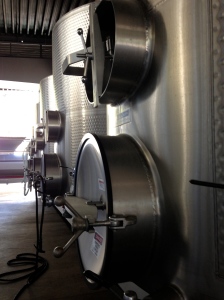 Barrels to start the fermentation process
Barrels to start the fermentation process  Going underground into the modern caves
Going underground into the modern caves  Whereas all the other caves we saw were very old and natural, with mold (good mold that produces oxygen we’re told) growing on the walls and ceilings, Cade had a more sterile feel to the tunnels where the barrels are housed to age. They also used this big cement egg as one (of many) fermentation process. Again, the guide went a little too fast for me to get a handle on how this works or why you would use it as opposed to other methods.
Whereas all the other caves we saw were very old and natural, with mold (good mold that produces oxygen we’re told) growing on the walls and ceilings, Cade had a more sterile feel to the tunnels where the barrels are housed to age. They also used this big cement egg as one (of many) fermentation process. Again, the guide went a little too fast for me to get a handle on how this works or why you would use it as opposed to other methods.
By our fifth day of wine tastings, we were exhausted and could barely stand the smell of wine in the morning (because it really does pervade the air there). Mark had a sore throat from the dry air and the hotel AC and we debated whether to skip out on the last two tours. I’m so glad we chose to go. As I discussed in the last post, we went to Opus One in the afternoon, with our wonderful guide, Hank, from whom I learned so much. In the morning, we went to the Hess Collection. The owner, Swiss entrepreneur Donald Hess, owns vineyards throughout the world, and perhaps more importantly, has a massive modern art collection that anyone can view for free (in Napa at least). His collection is split up across his vineyards and his home, and the pieces that were on display in Napa were pretty cool. He had some pieces by Francis Bacon (disturbed Irish artist), and apparently a Picasso (but that is at his home in Switzerland).
Some of the more interesting works were: a typewriter on fire (gas fueled), a lacy-looking curtain installation created completely of twigs (no glue or ropes holding the sticks together), and a massive slab of what looked to be dried mud, complete with tire tracks and bits of pebbles and mica and other natural bits that would be found in dried dirt. In fact that was made completely out of fiberglass. Even millimeters away from it, I couldn’t tell that it wasn’t dirt. Crazy! I also really loved an installation of melted rocks in various states of smoosh. Basically the artist put rocks in a kiln until they started cracking and melting. Some looked like huge dinosaur poop and some looked the way cookies look in the oven as the raw balls of dough start to dry, crack and then puddle into chewy cookies! I really wanted to touch one to see what it felt like. I was told I could not, but the guide assured me it just felt like a rock – I guess that’s not a shock. It was definitely worth getting up and moving at the end of the week.
The trip overall was fantastic, an although I was definitely “wined out” (if that’s even possible), I can’t wait to go back! I would do fewer tastings each day, but I would definitely recommend Chateau de Vie bed and breakfast for the warm hospitality, homemade breakfasts and poolside lounge chairs. I would go back to Conn Creek to do the make-your-own-wine class, and I would hit up one or two of the larger wineries, just for comparison. Perhaps Mondavi. There is also a wine train, which seems touristy, but let’s be honest, the whole town is touristy, so may as well enjoy! We were tempted to go to the hot springs, petrified forest or Old Faithful geyser, but many of the online reviews poo-pooed these things for being too expensive (i.e. $10 entrance fee) and not worth it. Maybe next time. We would definitely do some hiking, and we would try to eat at the CIA (Culinary Institute of America) which apparently has fabulous food in their student-run restaurant.
Back to reality now in Ann Arbor, where it is cold, grey and rainy today. I’m keeping warm making pumpkin bread and roasted pumpkin seeds 🙂





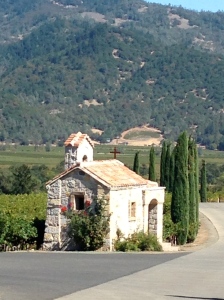



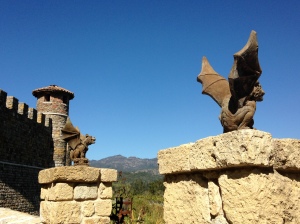
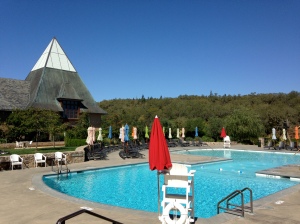


Good catch-up on several NSTBD editions this afternoon! Love them all and am now homesick for SF… Luckily meeting my BF from there “mid-way” in Chicago on the next bank holiday, where we are sure to try lots of pizza 🙂 Say hello to Mark Lowe!
LikeLike